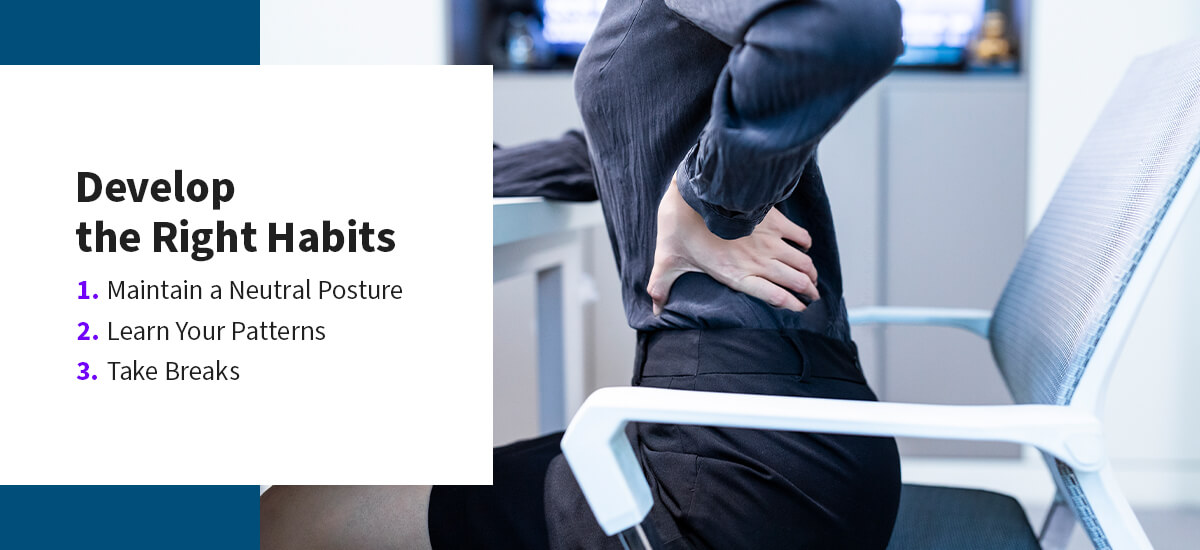Office jobs, remote jobs and working from home are standard today. Technology lets us stay more connected than ever. That means your office is wherever your desk is — but no matter where your desk is, back pain and poor posture may follow. The simple solution is to learn how to support your back while working.
It’s up to you to maintain good posture and workstation ergonomics, but that’s easier said than done. It’s easy to forget about your posture. When you’re busy with work, your mind is on the tasks at hand, and sometimes you forget you are slouching or leaning forward too much.
These tips will help you support your back working at desks so you can stay comfortable and productive.
Back Pain Awareness
The most effective first step you can take towards learning how to prevent pain sitting at desks is to know the causes of back pain and why supporting your back is so crucial. The two types of back pain are:
- Acute back pain: This pain is commonly brought about by accidents, falls or lifting heavy things without correct form or help. Acute back pain sometimes heals on its own and lasts anywhere from a few days to a few weeks.
- Chronic back pain: This is less common than acute back pain and can last for months or years at a time. Symptoms can sometimes be managed without surgery or may require a combination of surgery and physical therapy to treat.
Without the right posture, you are at risk of both types of back pain. Healthy sitting habits and the correct office ergonomics are worth the investment. The benefits of good posture include:
- Reduced back pain and muscle fatigue.
- Fewer spinal-related headaches.
- Higher energy levels throughout the day.
- Less shoulder and neck tension.
- Reduced chance of misalignment in the bones and joints.
- A more confident appearance.
- Less stress on spinal ligaments.
Develop the Right Habits
Proper habits will help you correct your posture, notice when your posture is off and gives you the foundation you need to prevent back pain from sitting at desks while working. Here are some reliable ways to establish the right back support and posture habits:
1. Maintain a Neutral Posture
Neutral posture refers to the spine’s natural alignment when your back and neck are completely straight. Here are some neutral posture tips to keep in mind at your desk:
- Make sure your computer monitor is always at eye level. Position it so your head won’t tilt too far up or down.
- Keep your back flat against your chair while pulling your shoulders back.
- Your feet must be flat on the ground. Don’t cross your legs or ankles, and make sure they are touching the floor or a stool as often as possible.
- Invest in lumbar support tools to help improve posture, support your back and prevent slouching.
2. Learn Your Patterns
Take note of any stiffness, soreness and aching in the neck, back and shoulders. Make daily notes as the symptoms occur. This will help you develop patterns and routines to reduce, prevent and alleviate your pain and help you correct your posture. Knowing your patterns and when how to correct unhealthy ones makes it easy to develop the right habits and support your back while you work.
3. Take Breaks
A driving force in why desk work causes back pain is because it limits the ability to move enough to keep your spine healthy. Scheduling regular short breaks from your office every half hour and as needed can reduce your pain and some back-related health risks. Use these breaks to stretch, take a short walk or get in some quick exercise.
Set yourself a reminder or reminders while you develop this habit. This will help you cultivate a good routine for movement breaks that will do wonders for your posture and help reduce back, shoulder and neck pain.
Achieving Effective Office Ergonomics
These insightful ergonomic tips for your desk will help optimize your workstation to keep your posture healthy:
Choosing the Right Chair
An ergonomic office chair needs to:
- Support your spinal curves.
- Keep your thighs parallel to the floor.
- Keep your feet resting flat on the floor.
- Have armrests that gently support your arms and keep your shoulders relaxed.
Sitting at Your Desk
Follow these tips for the best desk setup ergonomics:
- Keep your mouse should be easy to reach and on the same surface as the keyboard.
- Keep your wrists straight, hands slightly below your elbows and upper arms close to your body.
- Minimize how often you use your mouse by using keyboard shortcuts.
- Adjust your mouse sensitivity to respond to a light touch.
- Ensure a clear space for your thighs, feet and knees under your desk.
- Raise your desk with sturdy blocks and boards or desk raisers if it’s too low.
- Support your feet with a footrest if needed.
- Use a wrist rest near the keyboard and mouse.
Back Stretches and Exercises
There is a wide variety of exercises you can do at or near your desk. Try out a couple of different stretches to find the ones that work best for you. Desk exercises do more than help you with your posture — they also stimulate blood flow to refresh your mind and body. Just five to 10 minutes of exercise could help you beat your afternoon slump.
Consider some or all of the following next time you feel any fatigue or discomfort setting in:
- Lunges
- Squats
- Torso stretches
- Shoulder shrugs
- Seated spinal rotation
- Upper body and arm stretch
Get Back Support From Upper Cervical Chiropractic of NY
These essential tips will help you develop the proper habits and optimize your ergonomics for the best way to support your back while working at your desk. Backaches hinder your ability to work, negatively impact your health and could lead to costly procedures if left untreated.
Upper Cervical Chiropractic of NY specializes in chiropractic techniques that correct spinal misalignments at the source. With years of experience, we can help you with a vast range of conditions you might be dealing with. More than just chronic neck and back pain, we also help patients manage some symptoms of Parkinson’s Disease, Scoliosis, seizures and epilepsy, multiple sclerosis and much more. We can also help some patients in the process of recovering from auto accidents.
Whatever you might need our chiropractic insights for, we are happy and more than qualified to help. Contact us to find out what we can do for you today.




